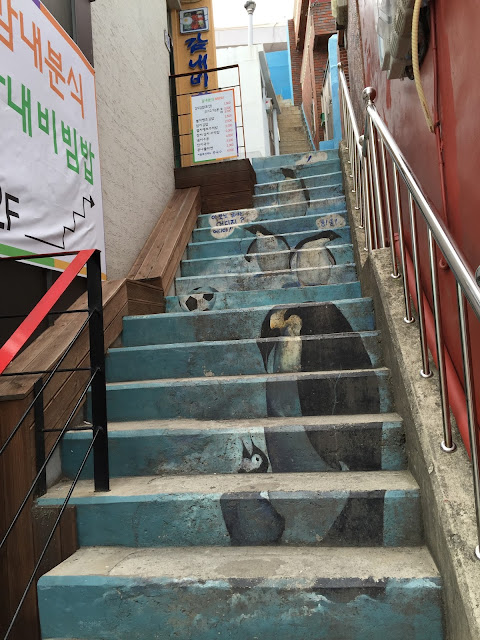By the looks of it, Gamcheon does bring to mind places like Santorini, given its many small, brightly colourful buildings all clustered on a hillside. But history paints a much less glamorous version of things though. Gamcheon has long been home to the city’s poorest residents, living in less than ideal living conditions. Its population swelled during the Korean War in 1950s, when war refugees fled their homes for the relative safety of Busan, the only area of the peninsula that remained free from fighting. Interestingly, the houses that are built in Gamcheon during this period were built in such a way as not to block the adjacent housings. It is said that this adheres to the local religion Taegeukdo’s teaching of allowing others to prosper. While the war ended and the rest of the country quickly developed into an economic powerhouse as we know today, Gamcheon still lagged behind the rest of Busan. Then in 2009, the local government embarked on an art project as a way to revitalise the village. Artists were hired to paint murals on the already colourful walls of the village and residents and students were roped in create artworks for their neighbourhood. The experiential creative space soon drew the notice of locals and curious tourists started to stream in. With the revenues generated by tourism, this also meant more money channelled into improving the living environment for residents.

Today, Gamcheon remains an extremely popular tourist destination for anyone who visits Busan. Hordes of photographers and selfie queens throng the small streets and twisty alleys daily in search of unique murals and art installations. In fact, it was so crowded when we went there that it was almost impossible to take a photo without someone else photobombing you behind. Long queues also formed neared the more popular art installations, with people jostling to take pictures.


Personally, while I found the history of the place quite fascinating, I thought the place was a little overrated. Yes, the murals are very pretty and there are loads of photo ops for the selfie queens, but there were simply too many people there, which destroyed the village's initial charm of being a quaint hidden find. Besides, there seems to be a proliferation of such similar arts villages elsewhere in the country, which made it lose what made it unique in the first place. Such a pity.
To leave Gamcheon, board the mini bus from the bus stop opposite the Gamcheon Village intersection. It’s a super crowded mess here, with tons of cars and tour buses, so do be careful when crossing the road. We tried flagging a cab but couldn’t get one, so had to take the super crowded public bus to the nearest subway station (Toseong Station). The ride itself is akin to a thrilling rollercoaster ride. Hold on for dear life as the mini bus rambles downhill and swerves round the sweeping bends. I swear the bus driver thinks he is racing in F1. You can’t miss the Toseong station though, almost everyone gets off here.







No comments:
Post a Comment
Thanks for your comment!